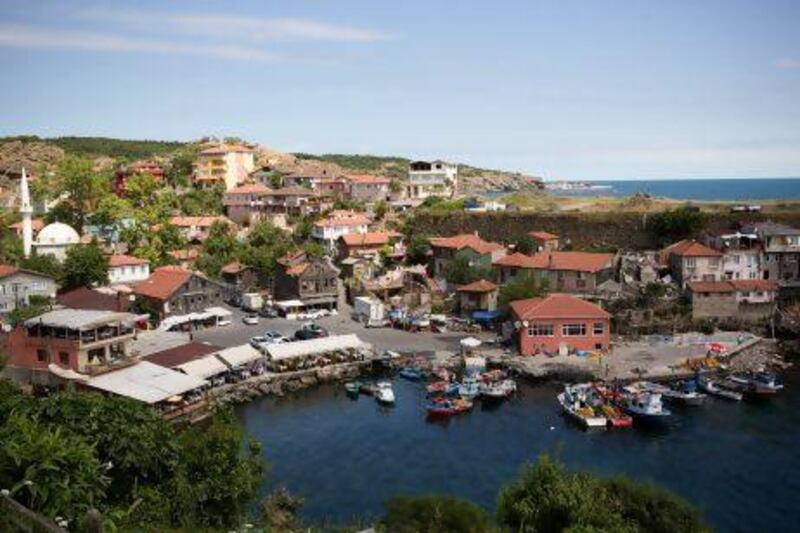GARIPCE, TURKEY // Elvan Aslan says the quiet days in this small fishing village on the Bosphorus may be gone for ever.
"At this time of year, we should hear the nightingales sing at night," said Ms Aslan, who lives in Garipce. "But when I am in bed at night and listen, all I hear is construction noise, not the birds."
Yesterday, Turkey's leaders attended a ceremony outside the village to mark the construction of a new bridge that will connect Europe and Asia.
For the Turkish government, the US$2.5 billion (Dh9.2bn) bridge is a symbol of the country's ambition and economic power. But some Turks are opposed to the project, fearing that it will change their lives for the worse.
Garipce is a little harbour in a cove on the European shore of the Bosphorus. Surrounded by mulberry, fig and pomegranate trees, it lies on the northern fringes of Turkey's metropolis Istanbul. Fishing is the main source of income for most of the 450 people who live here.
Ms Aslan, a housewife who has lived in Garipce for decades, is worried that the bridge, just half a kilometre from her village, will spoil the area's natural beauty, while some activists and opposition leaders claim its construction will cause environmental damage.
The government has swept aside these concerns. Work, both on the European side near Garipce and on the Asian side, began weeks before Abdullah Gul, the president, and Recep Tayyip Erdogan, the prime minister, oversaw the official start of the project yesterday.
If all goes to plan, the suspension bridge will open in exactly two years, on May 29, 2015. Its eight car lanes and two rail tracks should alleviate Istanbul's notorious traffic, according to the government.
Held on the anniversary of the Ottoman conquest of Constantinople on May 29, 1453, yesterday's ceremony for the bridge, which will be 1,275 metres long, highlighed Turkey's self-confidence as a growing political and economic power.
"We are a great nation," Mr Erdogan declared during the televised ceremony, while Mr Gul said that "friend and foe can see that Turkey's future will be bright".
The bridge, named Yavuz Sultan Selim Bridge, after a 16th-century Ottoman ruler who conquered much of the Middle East, will be Istanbul's third highway connection across the Strait, after the Bosphorus Bridge, which opened in 1973, and the Fatih Sultan Mehmet Bridge, built in 1988. The new bridge is part of a planned highway system, called the North Marmara Highway Project, which will sweep around Istanbul's east, north and west periphery.
The existing two Bosphorus bridges are bottlenecks that cause severe road congestion in Istanbul every day. A workday commute from the city's Asian sector to a job on the European side, or vice versa, can take several hours each way. About 140 million vehicles cross the two bridges every year.
The traffic overload results in an annual cost of $1.9bn to Turkey's economy in wasted petrol and lost working hours, according to the government.
But critics say the bridge will wreak major environmental damage and fail to reduce traffic on Istanbul's clogged roads.
"Bridges do not reduce traffic, they produce their own traffic," the Platform for Life instead of a 3. Bridge, a group campaigning against the bridge, said in a statement.
Ms Aslan also fears that a ban on new housing, designed to preserve the natural beauty of the wooded region near the mouth of the Bosphorus to the Black Sea, will be lifted once the bridge is in operation.
Property agents were already asking for land prices, she said.
The bridge is one of several high-profile infrastructure projects that the Turkish government wants to finish by 2023, the republic's 100th anniversary. To the north-west of the new bridge, preliminary work has started on a new airport, the world's biggest, scheduled to open in 2017, and the government is also looking at plans to dig a new canal connecting the Black Sea and the Sea of Marmara, to the west of Istanbul.
Tuncer Ozyavuz, a member of Istanbul's municipal parliament for the opposition Republican People's Party, said last week the new bridge and the new airport would "stab Istanbul's north like a dagger", destroying forests and water reservoirs.
He added that Mr Erdogan himself rejected the idea of a third bridge over the Bosphorus during his time as mayor of Istanbul in the 1990s.
Ictas Insaat Sanay, a Turkish construction company, last month won the tender to build the bridge with an Italian partner, Astaldi, and the Korean company Hyundai.
Critics say Istanbul's traffic problems would be better solved by boosting public transport than by building more roads and bridges.
Semih Tezcan, a retired professor of engineering at Istanbul's Bosphorus University, said last October that a railway line beneath the Bosphorus would be a much better way to get commuters across the Strait.
"It's people who have to get from one side to the other, not vehicles," Prof Tezcan told the Architects' and Engineers' Group, a professional association.
A rail connection underneath the Sea of Marmara, linking Istanbul's Asian part with the south of the historic city centre on the European side, is scheduled to open later this year, but that link is not expected to reduce traffic on the bridges much because it will be out of the way for most commuters.
[ tseibert@thenational.ae ]
twitter: For breaking news from the Gulf, the Middle East and around the globe follow The National World. Follow us






